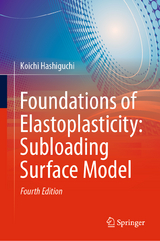
Foundations of Elastoplasticity: Subloading Surface Model
Springer International Publishing (Verlag)
978-3-319-48819-6 (ISBN)
- Lieferbar
- Versandkostenfrei
- Auch auf Rechnung
- Artikel merken
This book is the standard text book of elastoplasticity in which the elastoplasticity theory is comprehensively described from the conventional theory for the monotonic loading to the unconventional theory for the cyclic loading behavior. Explanations of vector-tensor analysis and continuum mechanics are provided first as a foundation for elastoplasticity theory, covering various strain and stress measures and their rates with their objectivities.
Elastoplasticity has been highly developed by the creation and formulation of the subloading surface model which is the unified fundamental law for irreversible mechanical phenomena in solids. The assumption that the interior of the yield surface is an elastic domain is excluded in order to describe the plastic strain rate due to the rate of stress inside the yield surface in this model aiming at the prediction of cyclic loading behavior, although the yield surface enclosing the elastic domain is assumed in all the elastoplastic models other than the subloading surface model. Then, the plastic strain rate develops continuously as the stress approaches the yield surface, providing the advantages: 1) The tangent modulus changes continuously, 2) The yield judgment whether the stress reaches the yield surface is not required, 3) The stress is automatically attracted to the yield surface even when it goes out from the yield surface by large loading increments in numerical calculation and 4) The finite strain theory based on the multiplicative decomposition of deformation gradient tensor is formulated exactly. Consequently, the monotonic, the cyclic, the non-proportional loading behaviors for wide classes of materials including soils, rocks and concretes in addition to metals can be described rigorously by the subloading surface model.
Further, the viscoplastic constitutive equations in a general rate from the quasi-static to the impact loadings are described, and constitutive equations of friction behavior and its application to the prediction of stick-slip phenomena, etc. are also described in detail. In addition, the return-mapping algorithm, the consistent tangent modulus, etc. are explained for the numerical analyses. Further, the damage, the phase-transformation and the crystal plasticity models are also described in brief. All of them are based on the subloading surface model. The elastoplasticity analysis will be advanced steadily based on the subloading surface model.
Vector and Tensor Analysis.- Motion and Strain (Rate).- Stress Tensors and Conservation Laws.- Objectivity and Objective (Rate) Tensors.- Elastic Constitutive Equations.- Basic Formulations for Elastoplastic Constitutive Equations.- Unconventional Elastoplasticity Model: Hashiguchi (Subloading Surface) Model.- Cyclic Plasticity Model: Critical Reviews and Assessments.- Extended Subloading Surface Model.- Constitutive Equations of Metals.- Constitutive Equations of Soils.- Multiplicative Elastoplasticity: Subloading Finite Strain Theory.- Subloading-Overstress model.- Subloading-Damage Model.- Subloading-Phase transformation model.- Corotational Rate Tensor.- Localization of Deformation.- Constitutive Equation for Friction: Subloading-Friction Model.- Subloading-Crystal Plasticity.- Implicit Stress Integration: Return-Mapping and Consistent Tangent Modulus Tensor.- On Formulations from Thermodynamic View-Point.
"The book covers an amazingly wide range of issues in elastoplasticity, and in continuum mechanics in general. It is written in modern notation and easily accessible to readers with a minimal background in continuum mechanics and tensor analysis. ... Altogether, the book gives an excellent introduction to the vast area of elastoplasticity and can be recommended not only for beginners in the field, but also for senior scientists interested in alternatives to the classical approach." (Dieter Weichert, Mathematical Reviews, October, 2019)
“The book covers an amazingly wide range of issues in elastoplasticity, and in continuum mechanics in general. It is written in modern notation and easily accessible to readers with a minimal background in continuum mechanics and tensor analysis. … Altogether, the book gives an excellent introduction to the vast area of elastoplasticity and can be recommended not only for beginners in the field, but also for senior scientists interested in alternatives to the classical approach.” (Dieter Weichert, Mathematical Reviews, October, 2019)
| Erscheinungsdatum | 20.12.2016 |
|---|---|
| Zusatzinfo | XXIII, 796 p. 195 illus., 160 illus. in color. |
| Verlagsort | Cham |
| Sprache | englisch |
| Maße | 155 x 235 mm |
| Themenwelt | Mathematik / Informatik ► Mathematik ► Wahrscheinlichkeit / Kombinatorik |
| Naturwissenschaften ► Physik / Astronomie ► Mechanik | |
| Technik ► Maschinenbau | |
| Schlagworte | classical mechanics • Constitutive equation of friction • Constitutive equations of metals and soils • Continuum Mechanics and Mechanics of Materials • Elastizität • Elastoplastic constitutive equation • Elastoplasticity Theory • Engineering • Engineering: general • Mechanical engineering and materials • Plastizität • Viscoplastic constitutive equation |
| ISBN-10 | 3-319-48819-8 / 3319488198 |
| ISBN-13 | 978-3-319-48819-6 / 9783319488196 |
| Zustand | Neuware |
| Informationen gemäß Produktsicherheitsverordnung (GPSR) | |
| Haben Sie eine Frage zum Produkt? |
aus dem Bereich



